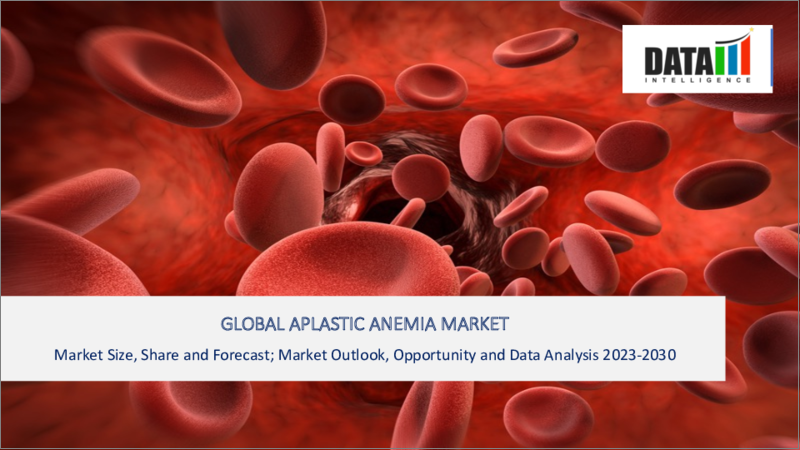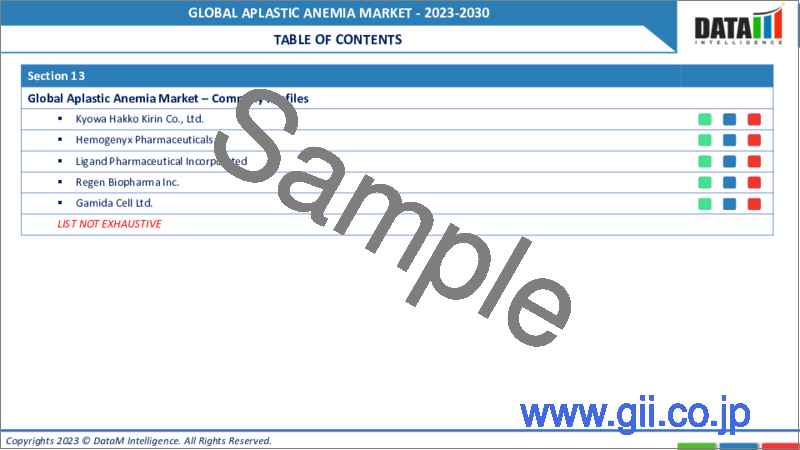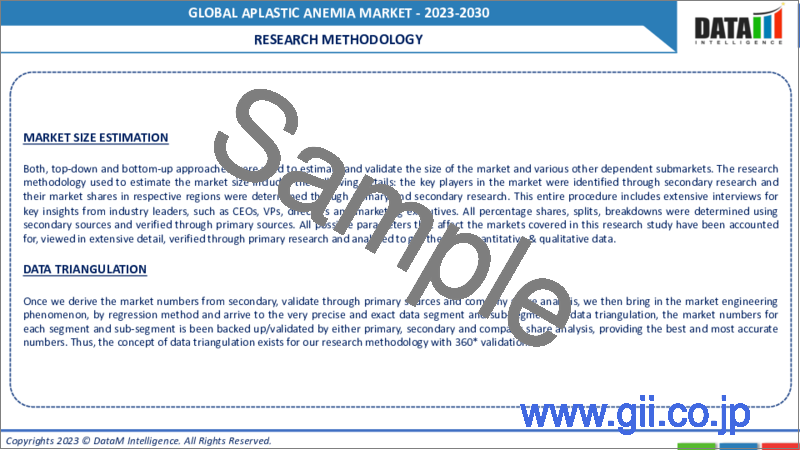|
|
市場調査レポート
商品コード
1140738
再生不良性貧血の世界市場-2022-2029Global Aplastic Anemia Market - 2022-2029 |
||||||
|
● お客様のご希望に応じて、既存データの加工や未掲載情報(例:国別セグメント)の追加などの対応が可能です。 詳細はお問い合わせください。 |
|||||||
| 再生不良性貧血の世界市場-2022-2029 |
|
出版日: 2022年10月20日
発行: DataM Intelligence
ページ情報: 英文 170 Pages
納期: 約2営業日
|
- 全表示
- 概要
- 目次
市場力学
世界の血液疾患患者数の増加が市場成長の原動力
再生不良性貧血は、体内で新しい血液細胞が十分に生成されなくなることで起こる疾患です。この疾患により、人は疲れやすくなり、制御不能な出血や感染症にかかりやすくなります。再生不良性貧血は、稀で重篤な体質であり、年齢に関係なく発症する可能性があります。再生不良性貧血は、突然起こることもあれば、ゆっくりと時間をかけて悪化していくこともあります。再生不良性貧血には、中等度と重度のものがあります。再生不良性貧血は、薬物療法、輸血、幹細胞移植(骨髄移植とも呼ばれる)によって治すことができます。再生不良性貧血市場の成長を促進している主な要因は、世界中で血液疾患の患者数が増加していることと、世界中でがん患者数が増加していることです。さらに、再生不良性貧血の技術的進歩や製薬分野における研究開発活動の活発化が、市場成長のための好機を生み出しています。
地理的浸透度。
北米地域が再生不良性貧血の世界市場を独占すると予想される
本調査では、再生不良性貧血市場を地域別に分析し、北米、欧州、アジア太平洋、南米、中東・アフリカなどの世界市場を対象としています。
2021年の再生不良性貧血の世界市場では、北米が圧倒的な地位を占めています。米国は、予測期間中に北米のかなりの成長を表すと予想されます。米国では、血液疾患の高い有病率により、再生不良性貧血は潜在的な成長を遂げると予想されます。また、北米は予測期間中に金額ベースで大きな成長を見せると予想されます。再生不良性貧血と骨髄疾患の有病率の上昇が、同地域の市場成長を促進すると予想されます。
アジア太平洋地域の再生不良性貧血市場は、インドと中国における製薬業界の成長と技術進歩に支えられ、予測期間中に急成長を遂げると予想されます。また、人口の増加や慢性疾患の蔓延により、アジア太平洋地域の再生不良性貧血市場の成長も見込まれています。
競合情勢。
再生不良性貧血の世界市場の成長に貢献している主な企業は、Bayer AG、Novartis AG、Pfizer Inc、Ligand Pharmaceuticals Incorporated、Genezyme Corporation、Mylan N.V., BIOGEN、OTSUKA Pharmaceutical Co.Ltd.、Regen Biopharma Inc.、BiolinRxなどがあります。大手企業は再生不良性貧血市場の世界の成長のために、新製品の上市や拡大戦略を採用しています。2021年8月、Pfizer社はGlobal Blood Therapeutics社を54億米ドルで買収しました。この買収により、同社のレアヘマトロジーにおけるプレゼンスは強化されます。この買収により、鎌状赤血球症の主要な専門的ポートフォリオとパイプラインがファイザーに拡大され、全世界のピーク売上高の合計が30億米ドル以上となる可能性があります。2020年10月、ライガンドはPfenex Inc.を現金4億3750万米ドルと、特定のマイルストーンを達成した場合に現金7800万米ドルの成功報酬を受け取る権利を表す1株当たりの譲渡不可の成功報酬権(CVR)で買収を完了しました。この買収により、貴重な技術プラットフォームと、治療薬やワクチンに関する大手製薬会社とのロイヤルティ支払い義務のある共同研究ポートフォリオが提供されます。2022年6月、BioLineRxはGenFleet Therapeuticsと、膵管腺癌(PDAC)におけるMotixafortideの開発に関する共同研究契約を締結したことを発表しました。この提携は、転移性PDACの二次治療としてMotixafortideと抗PD-1および化学療法を併用した第2a相COMBAT/KEYNOTE-202試験の良好な最終結果に基づいており、この非常に難しい疾患における開発の継続に強い支援を提供するものであります。
COVID-19の影響世界の再生不良性貧血市場にポジティブな影響を与えます。
COVID-19の発生は、世界の再生不良性貧血市場の成長にプラスの影響を及ぼしています。再生不良性貧血の治療を積極的に受けるため、免疫抑制は感染症や合併症の高いリスクを伴いますが、免疫抑制により炎症性組織の後期破壊が抑えられれば有益と考えられます。したがって、COVID-19のパンデミックは、2020年の再生不良性貧血の市場価値を牽引しました。
世界の再生不良性貧血市場レポートでは、約69の市場データ表、60の図、170ページの構成で提供しています
目次
第1章 調査手法と調査範囲
- 調査手法
- 調査目的および調査範囲
第2章 市場の定義と概要
第3章 エグゼクティブサマリー
- 治療タイプ別市場内訳
- 疾患タイプ別市場内訳
- 投与経路別市場内訳
- 流通チャネル別市場内訳
- 地域別市場内訳
第4章 市場力学
- 市場影響要因
- 促進要因
- 世界の血液疾患患者数の増加
- 癌患者の増加
- 抑制要因
- 高い治療費
- 影響分析
- 促進要因
第5章 産業分析
- ポーターのファイブフォース分析
- サプライチェーン分析
- バリューチェーン分析
- PEST分析
- プライシング分析
- 法規制分析
- 保険償還分析
- アンメットニーズ
- 特許動向
第6章 COVID-19の分析
- COVID-19の市場分析
- COVID-19以前の市場シナリオ
- COVID-19の現在の市場シナリオ
- COVID-19の後、あるいは将来のシナリオ
- COVID-19の中での価格ダイナミクス
- 需要-供給スペクトラム
- パンデミック時の市場に関連する政府の取り組み
- メーカーの戦略的な取り組み
- まとめ
第7章 治療タイプ別
- 輸血
- 薬物療法
- 骨髄輸血
第8章 疾患タイプ別
- 後天性再生不良性貧血
- 遺伝性骨髄不全症候群
第9章 投与経路別
- 静脈内投与
- 経口投与
第10章 販売チャネル別
- 小売薬局
- 病院内薬局
- オンライン薬局
第11章 地域別
- 北米
- 米国
- カナダ
- メキシコ
- 欧州
- ドイツ
- 英国
- フランス
- イタリア
- スペイン
- その他欧州
- 南米
- ブラジル
- アルゼンチン
- その他の南米地域
- アジア太平洋地域
- 中国
- インド
- 日本
- オーストラリア
- その他アジア太平洋地域
- 中東・アフリカ地域
第12章 競合情勢
- 競合シナリオ
- 市況/シェア分析
- M&A(合併・買収)分析
第13章 再生不良性貧血の世界市場-企業プロファイル
- Bayer AG
- 企業概要
- 製品ポートフォリオと説明
- 主なハイライト
- 財務概要
- Novartis AG
- Pfizer Inc.
- Ligand Pharmceuticals Incorporated
- Genezyme Corporation
- Mylan N.V.
- BIOGEN
- Otsuka Pharmaceutical Co. Ltd.
- REGEN BIOPHARMA INC.
- BiolinRx(*LIST NOT EXHAUSTIVE)
第14章 重要考察
第15章 DataM
Market Overview
Aplastic Anemia Market was valued at USD YY million in 2021. It is forecasted to reach USD YY million by 2029, growing at a CAGR of YY% during the forecast period (2022-2029).
Aplastic anemia is a condition that happens when the body stops generating sufficient new blood cells. The condition leaves a person tired and more prone to uncontrolled bleeding and infections. Aplastic Anemia, a rare and serious condition, may develop at any age. It can happen suddenly or slowly and worsen over time. It can be either moderate or severe. Medications, blood transfusions or a stem cell transplant, also known as a bone marrow transplant, may be included in aplastic anemia treatment. The major factors propelling the growth of the aplastic anemia market are the rising number of blood disorder cases worldwide and the rising number of cancer patients globally. Moreover, the technological advancement in aplastic anemia and growing research & development activities in the pharmaceutical sector are further creating a lucrative opportunity for market growth.
Market Dynamics: Rising number of blood disorder cases worldwide drives the market growth
Aplastic anemia is a condition that happens when the body stops generating sufficient new blood cells. The condition leaves a person tired and more prone to uncontrolled bleeding and infections. Aplastic Anemia is a rare and serious condition of the body and may develop at any age. Aplastic anemia can happen suddenly or slowly and worsen over time. Aplastic Anemia can be either moderate or severe. Aplastic Anemia is cured by Medications, blood transfusions or a stem cell transplant, also known as a bone marrow transplant. The major factors propelling the growth of the aplastic anemia market are the rising number of blood disorder cases worldwide and the rising number of cancer patients globally. Moreover, the technological advancement in aplastic anemia and growing research & development activities in the pharmaceutical sector are further creating a lucrative opportunity for market growth.
Market Segmentation: The bone marrow transfusion/ stem cell therapy segment is projected to be the dominant segment in the market during the forecast period.
Based on the treatment type, the aplastic anemia market has been classified into bone marrow transfusion/stem cell therapy, blood transfusion and drug therapy.
For decades, hematopoietic stem cell transplantation has been used to treat blood and cardiovascular cell disorders, either unpatched or genetically altered to correct genetic disorders. Also, it is an efficient option for blood disorders with a success rate of over 80%, as per research presented by the American academy of orthopedic surgeons. Thus, rising blood disorders worldwide and efficient usage of stem cells in treating blood disorders are expected to drive the usage of bone marrow transfusion.
Aplastic anemia is segmented based on distribution channel, which includes retail pharmacies, hospitals pharmacies and online pharmacies.
Hospital pharmacies are held a significant market share in the aplastic anemia market. Hospital pharmacies held the dominant position in the global market during the forecast period. A hospital pharmacy is a specialized pharmacy integrated into the medical center's care. These include centers such as a hospital, outpatient clinics, drug-dependent facilities, poison control centers, and a drug information center at a residential care facility. The hospital's pharmacies are expected to gain potential growth in the forthcoming period due to the growing geriatric population and rising number of chronic diseases. Moreover, online pharmacies are expected to project a considerable CAGR during the forecast period. The rising e-commerce sector is expected to propel segment growth in the near future.
Additionally, aplastic anemia is segmented based on disease type, which includes acquired aplastic anemia and inherited bone marrow failure syndromes. Similarly, the route of administration includes intravenous and oral.
Geographical Penetration: North America region is expected to dominate the global aplastic anemia market
Based on geography, the study analyzes the aplastic anemia market in the global market, including North America, Europe, Asia-Pacific, South America, and the Middle East & Africa.
North America is holding a dominant position in the global aplastic anemia market in 2021. The U.S. is expected to represent considerable growth in North America during the forecast period. In the U.S., aplastic anemia is expected to have potential growth owing to the high prevalence rate of blood disorders. Moreover, North America is expected to represent significant growth in terms of value during the forecast period. The rise in the prevalence rate of aplastic anemia and bone marrow disorder is expected to propel market growth across the region.
The aplastic anemia market for the Asia Pacific is expected to observe rapid growth over the forecast period, backed by the growth of the pharmaceutical industry & technological advancement in India and China. Moreover, the increasing population and increasing prevalence of chronic diseases are expected to augment the growth of the Asia Pacific aplastic anemia market.
Competitive Landscape:
The key aplastic anemia players which are contributing to the growth of the global market include Bayer AG, Novartis AG, Pfizer Inc., Ligand Pharmaceuticals Incorporated, Genezyme Corporation, Mylan N.V., BIOGEN, OTSUKA Pharmaceutical Co. Ltd., Regen Biopharma Inc., and BiolinRx, among others. The major players are adopting new product launches and expansion strategies for global growth in the aplastic anemia market. In August 2021, Pfizer acquired Global Blood Therapeutics for $5.4 Billion. This acquisition enhances the company's presence in Rare Hematology. This acquisition expands the leading sickle cell disease expertise portfolio and pipeline to Pfizer with potential combined worldwide peak sales of more than $3 billion. In October 2020, Ligand completed the acquisition of Pfenex Inc. for $437.5 million in cash, plus one non-transferable contingent value right (CVR) per share, representing the right to receive a contingent payment of $78 million in cash if a certain specified milestone is achieved. This acquisition provides a valuable technology platform and portfolio of royalty-bearing collaborations with leading pharmaceutical companies for treatments and vaccines. In June 2022, BioLineRx announced a collaboration agreement with GenFleet Therapeutics to develop Motixafortide in Pancreatic Ductal Adenocarcinoma (PDAC). This collaboration is based on positive final results from Phase 2a COMBAT/KEYNOTE-202 study of Motixafortide in combination with anti-PD-1 and chemotherapy as second-line metastatic PDAC therapy, which provides strong support for continued development in this very challenging disease.
COVID-19 Impact: Positive impact on the global aplastic anemia market.
The outbreak of COVID-19 has positively impacted the growth of the aplastic anemia market globally. Since people receive active treatment for aplastic anemia, immunosuppression involves a higher risk of infection and complications; however, it may be beneficial if immunosuppression reduces the late destruction of hyperinflammatory tissue. Therefore, the COVID-19 pandemic drove the market value of the aplastic anemia market in 2020.
The global aplastic anemia market report would provide an access to approximately 69 market data tables, 60 figures and 170 pages
Table of Contents
1. Methodology and Scope
- 1.1. Research Methodology
- 1.2. Research Objective and Scope of the Report
2. Market Definition and Overview
3. Executive Summary
- 3.1. Market Snippet by Treatment Type
- 3.2. Market Snippet by Disease Type
- 3.3. Market Snippet by Route of Administration
- 3.4. Market Snippet by Distribution Channel
- 3.5. Market Snippet by Region
4. Market Dynamics
- 4.1. Market Impacting Factors
- 4.1.1. Drivers
- 4.1.1.1. Rising number of blood disorder cases across the world
- 4.1.1.2. Rising number of cancer patients
- 4.1.2. Restraint
- 4.1.2.1. High cost of treatment
- 4.1.3. Impact Analysis
- 4.1.1. Drivers
5. Industry Analysis
- 5.1. Porter's Five Forces Analysis
- 5.2. Supply Chain Analysis
- 5.3. Value Chain Analysis
- 5.4. PEST Analysis
- 5.5. Pricing Analysis
- 5.6. Regulatory Analysis
- 5.7. Reimbursement Analysis
- 5.8. Unmet Needs
- 5.9. Patent Trends
6. COVID-19 Analysis
- 6.1. Analysis of Covid-19 on the Market
- 6.1.1. Before COVID-19 Market Scenario
- 6.1.2. Present COVID-19 Market Scenario
- 6.1.3. After COVID-19 or Future Scenario
- 6.2. Pricing Dynamics Amid Covid-19
- 6.3. Demand-Supply Spectrum
- 6.4. Government Initiatives Related to the Market During Pandemic
- 6.5. Manufacturers Strategic Initiatives
- 6.6. Conclusion
7. By Treatment Type
- 7.1. Introduction
- 7.2. Market Size Analysis, and Y-o-Y Growth Analysis (%), By Treatment Type Segment
- 7.3. Market Attractiveness Index, By Treatment Type Segment
- 7.3.1. Blood transfusion
- 7.3.1.1. Introduction
- 7.3.1.2. Market Size Analysis, and Y-o-Y Growth Analysis (%)
- 7.3.2. Drug therapy
- 7.3.3. Bone Marrow Transfusion
- 7.3.1. Blood transfusion
8. By Diseases Type
- 8.1. Introduction
- 8.2. Market Size Analysis, and Y-o-Y Growth Analysis (%), By Disease Type Segment
- 8.3. Market Attractiveness Index, By Diseases Type Segment
- 8.3.1. Acquired aplastic anemia
- 8.3.1.1. Introduction
- 8.3.1.2. Market Size Analysis, and Y-o-Y Growth Analysis (%)
- 8.3.2. Inherited bone marrow failure syndromes
- 8.3.1. Acquired aplastic anemia
9. By Route of Administration
- 9.1. Introduction
- 9.2. Market Size Analysis, and Y-o-Y Growth Analysis (%), By Route of Administration Segment
- 9.3. Market Attractiveness Index, By Route of Administration Segment
- 9.3.1. Intravenous
- 9.3.1.1. Introduction
- 9.3.1.2. Market Size Analysis, and Y-o-Y Growth Analysis (%)
- 9.3.2. Oral
- 9.3.1. Intravenous
10. By Distribution Channel
- 10.1. Introduction
- 10.2. Market Size Analysis, and Y-o-Y Growth Analysis (%), By Distribution Channel Segment
- 10.3. Market Attractiveness Index, By Distribution Channel Segment
- 10.3.1. Retail pharmacies
- 10.3.1.1. Introduction
- 10.3.1.2. Market Size Analysis, and Y-o-Y Growth Analysis (%)
- 10.3.2. Hospital pharmacies
- 10.3.3. Online pharmacies
- 10.3.1. Retail pharmacies
11. By Region
- 11.1. Introduction
- 11.2. Market Size Analysis, and Y-o-Y Growth Analysis (%), By Region
- 11.3. Market Attractiveness Index, By Region
- 11.4. North America
- 11.4.1. Introduction
- 11.4.2. Key Region-Specific Dynamics
- 11.4.3. Market Size Analysis, and Y-o-Y Growth Analysis (%), By Treatment Type
- 11.4.4. Market Size Analysis, and Y-o-Y Growth Analysis (%), By Distribution Channel
- 11.4.5. Market Size Analysis, and Y-o-Y Growth Analysis (%), By Disease Type
- 11.4.6. Market Size Analysis, and Y-o-Y Growth Analysis (%), By Route of Administration
- 11.4.7. Market Size Analysis, and Y-o-Y Growth Analysis (%), By Country
- 11.4.7.1. U.S.
- 11.4.7.2. Canada
- 11.4.7.3. Mexico
- 11.5. Europe
- 11.5.1. Introduction
- 11.5.2. Key Region-Specific Dynamics
- 11.5.3. Market Size Analysis, and Y-o-Y Growth Analysis (%), By Treatment Type
- 11.5.4. Market Size Analysis, and Y-o-Y Growth Analysis (%), By Distribution Channel
- 11.5.5. Market Size Analysis, and Y-o-Y Growth Analysis (%), By Disease Type
- 11.5.6. Market Size Analysis, and Y-o-Y Growth Analysis (%), By Route of Administration
- 11.5.7. Market Size Analysis, and Y-o-Y Growth Analysis (%), By Country
- 11.5.7.1. Germany
- 11.5.7.2. U.K.
- 11.5.7.3. France
- 11.5.7.4. Italy
- 11.5.7.5. Spain
- 11.5.7.6. Rest of Europe
- 11.6. South America
- 11.6.1. Introduction
- 11.6.2. Key Region-Specific Dynamics
- 11.6.3. Market Size Analysis, and Y-o-Y Growth Analysis (%), By Treatment Type
- 11.6.4. Market Size Analysis, and Y-o-Y Growth Analysis (%), By Disease Type
- 11.6.5. Market Size Analysis, and Y-o-Y Growth Analysis (%), By Distribution Channel
- 11.6.6. Market Size Analysis, and Y-o-Y Growth Analysis (%), By Route of Administration
- 11.6.7. Market Size Analysis, and Y-o-Y Growth Analysis (%), By Country
- 11.6.7.1. Brazil
- 11.6.7.2. Argentina
- 11.6.7.3. Rest of South America
- 11.7. Asia Pacific
- 11.7.1. Introduction
- 11.7.2. Key Region-Specific Dynamics
- 11.7.3. Market Size Analysis, and Y-o-Y Growth Analysis (%), By Treatment Type
- 11.7.4. Market Size Analysis, and Y-o-Y Growth Analysis (%), By Disease Type
- 11.7.5. Market Size Analysis, and Y-o-Y Growth Analysis (%), By Distribution Channel
- 11.7.6. Market Size Analysis, and Y-o-Y Growth Analysis (%), By Route of Administration
- 11.7.7. Market Size Analysis, and Y-o-Y Growth Analysis (%), By Country
- 11.7.7.1. China
- 11.7.7.2. India
- 11.7.7.3. Japan
- 11.7.7.4. Australia
- 11.7.7.5. Rest of Asia Pacific
- 11.8. Middle East and Africa
- 11.8.1. Introduction
- 11.8.2. Key Region-Specific Dynamics
- 11.8.3. Market Size Analysis, and Y-o-Y Growth Analysis (%), By Treatment Type
- 11.8.4. Market Size Analysis, and Y-o-Y Growth Analysis (%), By Disease Type
- 11.8.5. Market Size Analysis, and Y-o-Y Growth Analysis (%), By Distribution Channel
- 11.8.6. Market Size Analysis, and Y-o-Y Growth Analysis (%), By Route of Administration
- 11.8.7. Market Size Analysis, and Y-o-Y Growth Analysis (%), By Country
12. Competitive Landscape
- 12.1. Competitive Scenario
- 12.2. Market Positioning/Share Analysis
- 12.3. Mergers and Acquisitions Analysis
13. Global Aplastic Anemia Market- Company Profiles
- 13.1. Bayer AG*
- 13.1.1. Company Overview
- 13.1.2. Product Portfolio and Description
- 13.1.3. Key Highlights
- 13.1.4. Financial Overview
- 13.2. Novartis AG
- 13.3. Pfizer Inc.
- 13.4. Ligand Pharmceuticals Incorporated
- 13.5. Genezyme Corporation
- 13.6. Mylan N.V.
- 13.7. BIOGEN
- 13.8. Otsuka Pharmaceutical Co. Ltd.
- 13.9. REGEN BIOPHARMA INC.
- 13.10. BiolinRx (*LIST NOT EXHAUSTIVE)
14. Premium Insights
15. DataM Intelligence Analysis
- 15.1. Appendix
- 15.2. About Us and Services
- 15.3. Contact Us




